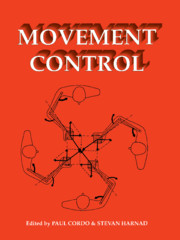Book contents
- Frontmatter
- Contents
- Preface
- 1 Does the nervous system use equilibrium-point control to guide single and multiple joint movements?
- 2 Does the nervous system depend on kinesthetic information to control natural limb movements?
- 3 Can sense be made of spinal interneuron circuits?
- 4 Implications of neural networks for how we think about brain function
- 5 Do cortical and basal ganglionic motor areas use “motor programs” to control movement?
- 6 Functional heterogeneity with structural homogeneity: How does the cerebellum operate?
- 7 Are movement parameters recognizably coded in the activity of single neurons?
- 8 The representation of egocentric space in the posterior parietal cortex
- Open Peer Commentary and Authors' Responses
- References
- Index
Preface
Published online by Cambridge University Press: 11 December 2009
- Frontmatter
- Contents
- Preface
- 1 Does the nervous system use equilibrium-point control to guide single and multiple joint movements?
- 2 Does the nervous system depend on kinesthetic information to control natural limb movements?
- 3 Can sense be made of spinal interneuron circuits?
- 4 Implications of neural networks for how we think about brain function
- 5 Do cortical and basal ganglionic motor areas use “motor programs” to control movement?
- 6 Functional heterogeneity with structural homogeneity: How does the cerebellum operate?
- 7 Are movement parameters recognizably coded in the activity of single neurons?
- 8 The representation of egocentric space in the posterior parietal cortex
- Open Peer Commentary and Authors' Responses
- References
- Index
Summary
Producing purposive movement is one of the most fundamental functions of the nervous system, yet it is arguably one of the most complex. Other functions of the brain, such as memory, vision, and the automatic control of homeostatic systems, have close analogues in engineering and computer science, but the production of robots that move “naturally” continues to elude us. This lack of success in replicating animallike movement is surely due to the complexity of the motor apparatus: skeletal, muscular, and neural. The human skeleton consists of 206 bones, roughly 100 articulations, and more than 600 muscles. This mechanical system is far more complex than any current robotic device. A large proportion of the nervous system – including the peripheral nerves, much of the spinal grey and white matter, and large portions of the brainstem, cerebellum, basal ganglia, and cerebral cortex – is involved in the production of coordinated movements. And yet we move almost effortlessly and without having to “think” about it.
Given this complexity, it should not be surprising that there exist in neuroscience research a large number of controversies concerning how the nervous system actually controls purposive movement. The articles and commentaries in this volume originated at the first of a series of conferences entitled “Controversies in Neuroscience.”
- Type
- Chapter
- Information
- Movement Control , pp. ix - xPublisher: Cambridge University PressPrint publication year: 1994



